1995 GMC SIERRA power steering
[x] Cancel search: power steeringPage 72 of 488
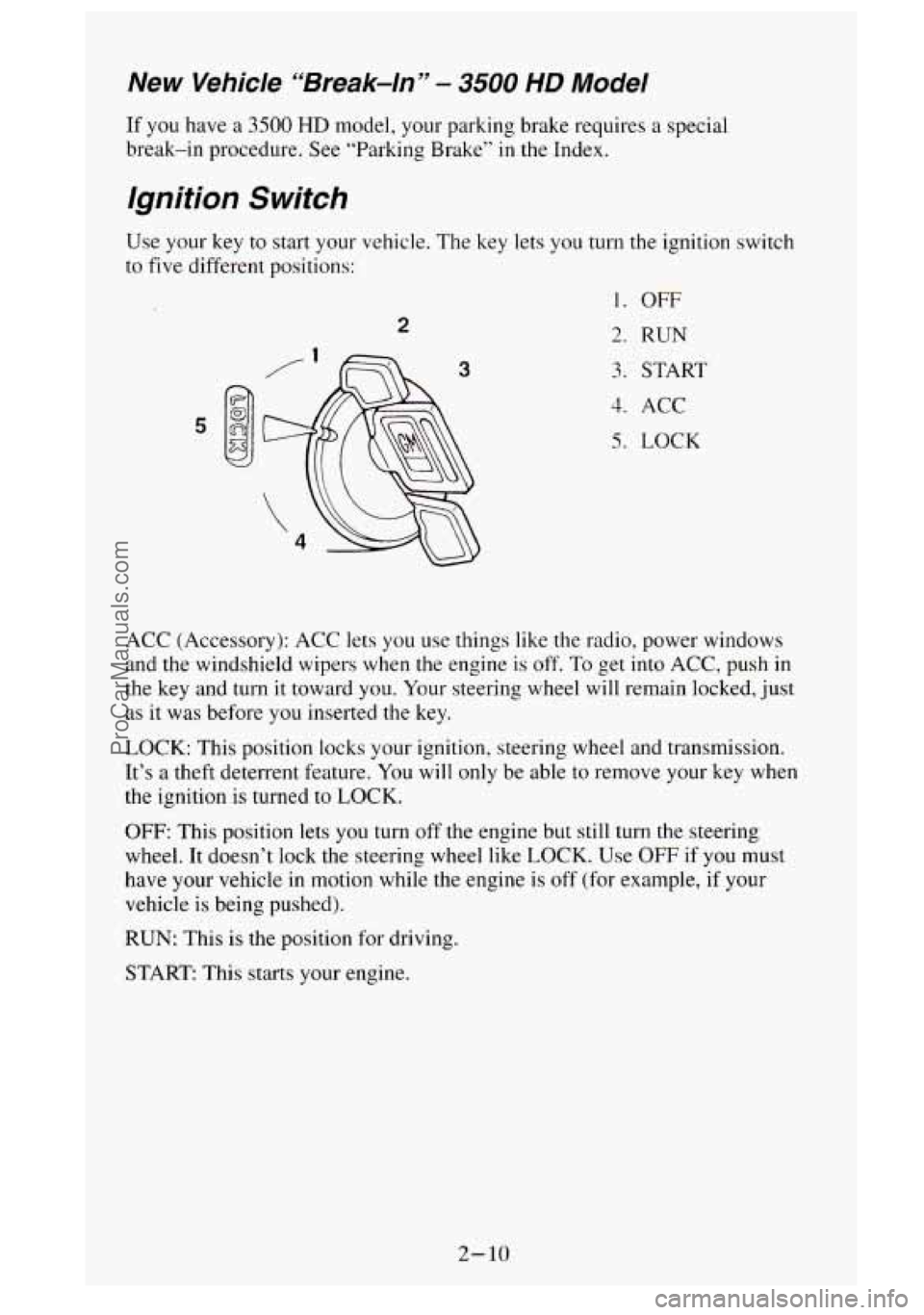
New Vehicle “Break-In” - 3500 HD Model
If you have a 3500 HD model, your parking brake requires a special
break-in procedure. See “Parking Brake”
in the Index.
Ignition Switch
Use your key to start your vehicle. The key lets you turn the ignition switch
to five different positions:
2
5
1. OFF
2. RUN
3. START
4. ACC
5. LOCK
ACC (Accessory):
ACC lets you use things like the radio, power windows
and the windshield wipers when the engine is off. To get into ACC, push in
the key and turn it toward you. Your steering wheel will remain locked, just
as it was before you inserted the key.
LOCK: This position locks your ignition, steering wheel and transmission.
It’s
a theft deterrent feature. You will only be able to remove your key when
the ignition
is turned to LOCK.
OFF: This position lets you turn off the engine but still turn the steering
wheel. It doesn’t lock the steering wheel like LOCK. Use
OFF if you must
have your vehicle
in motion while the engine is off (for example, if your
vehicle is being pushed).
RUN: This is the position for driving.
START: This starts your engine.
2- 10
ProCarManuals.com
Page 181 of 488
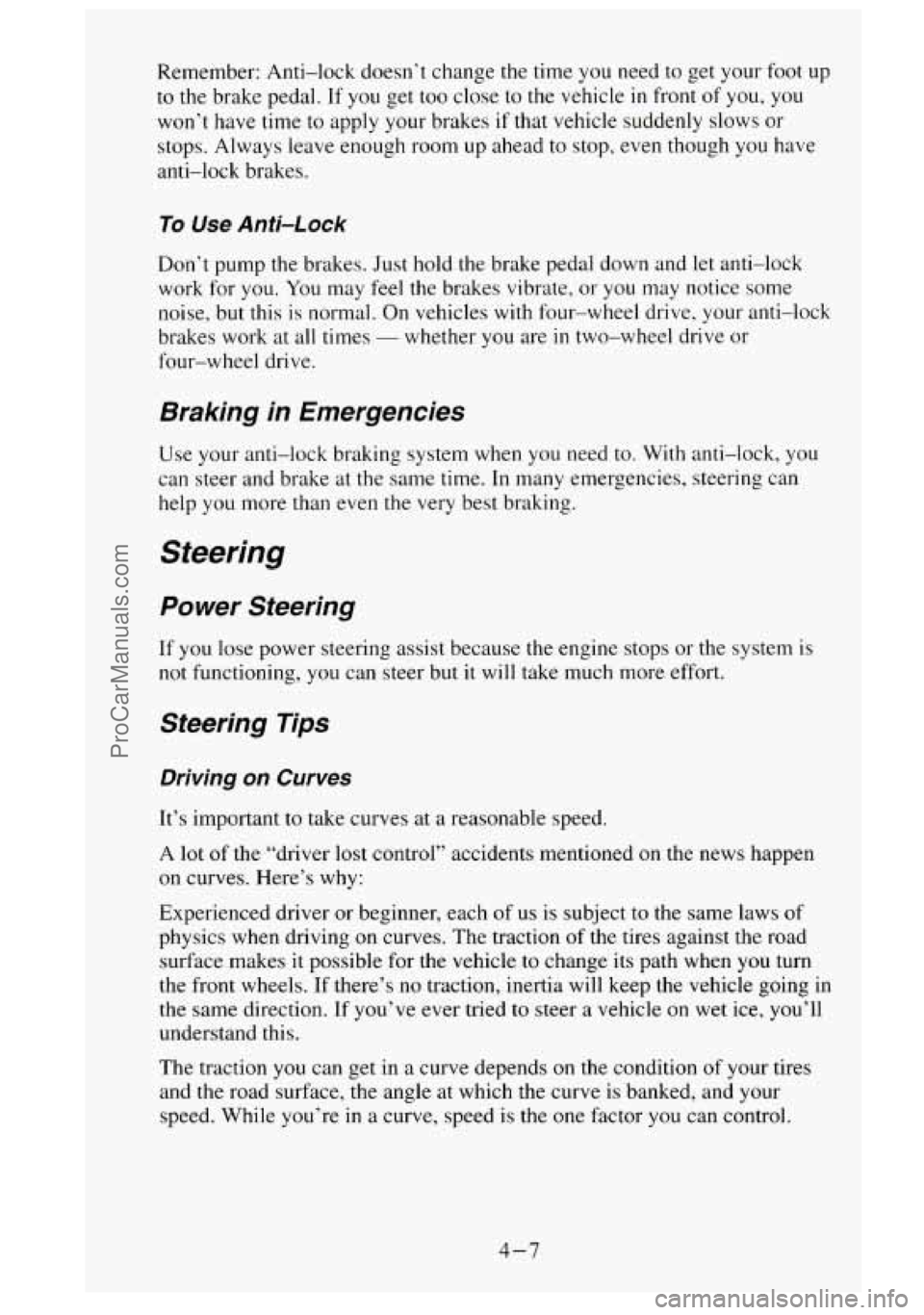
Remember: Anti-lock doesn’t change the time you need to get your foot up
to the brake pedal. If you get too close to the vehicle in front of you, you
won’t have time
to apply your brakes if that vehicle suddenly slows or
stops. Always leave enough room up ahead to stop, even though
you have
anti-lock brakes.
To Use Anti-Lock
Don’t pump the brakes. Just hold the brake pedal down and let anti-lock
work for you. You may feel the brakes vibrate, or you may notice some
noise, but this is normal. On vehicles
with four-wheel drive, your anti-lock
brakes work at all times
- whether you are in two-wheel drive or
four-wheel drive.
Braking in Emergencies
Use your anti-lock braking system when you need to. With anti-lock, you
can steer and brake at the same time. In many emergencies, steering can
help you more than even the very best braking.
Steering
Power Steering
If you lose power steering assist because the engine stops or the system is
not functioning, you can steer but it will take much more effort.
Steering Tips
Driving on Curves
It’s important to take curves at a reasonable speed.
A lot of the “driver lost control’’ accidents mentioned on the news happen
on curves. Here’s why:
Experienced driver or beginner, each of
us is subject to the same laws of
physics when driving on curves. The traction of the tires against the road
surface makes
it possible for the vehicle to change its path when you turn
the front wheels.
If there’s no traction, inertia will keep the vehicle going in
the same direction. If you’ve ever tried to steer
a vehicle on wet ice, you’ll
understand this.
The traction
you can get in a curve depends on the condition of your tires
and the road surface, the angle at which the curve is banked, and your
speed. While you’re
in a curve, speed is the one factor you can control.
4-7
ProCarManuals.com
Page 190 of 488
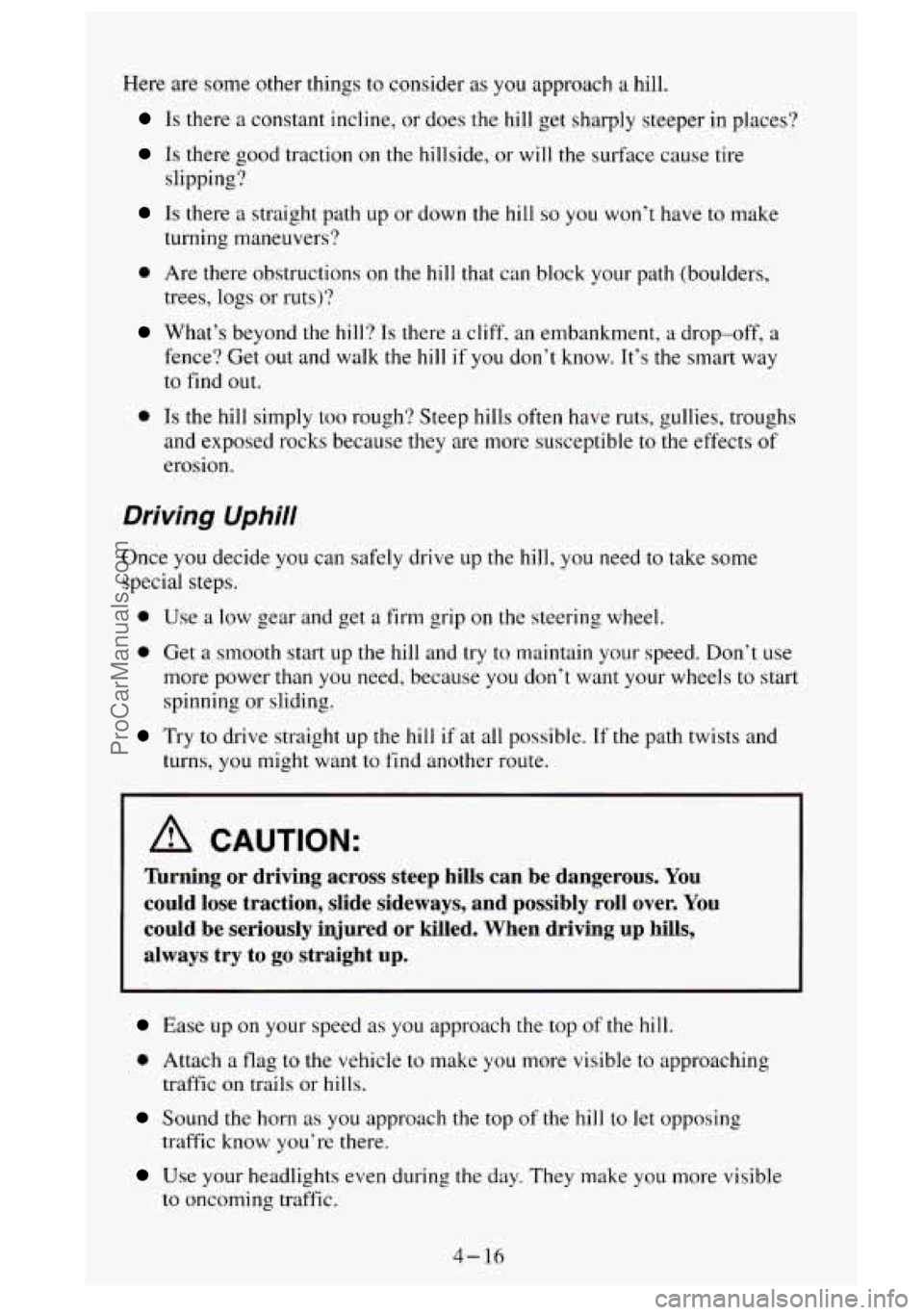
Here are some other things to consider as you approach a hill.
Is there a constant incline, or does the hill get sharply steeper in places?
Is there good traction on the hillside, or will the surface cause tire
slipping?
Is there a straight path up or down the hill so you won’t have to make
0 Are there obstructions on the hill that can block your path (boulders,
turning maneuvers?
trees,
logs or ruts)?
What’s beyond the hill? Is there a cliff, an embankment, a drop-off, a
fence? Get out and walk
the hill if you don’t know. It’s the smart way
to find out.
Is the hill simply too rough? Steep hills often have ruts, gullies, troughs
and exposed rocks because they are more susceptible
to the effects of
erosion.
Driving Uphi//
Once you decide you can safely drive up the hill, you need to take some
special steps.
0 Use a low gear and get a firm grip on the steering wheel.
0 Get a smooth start up the hill and try to maintain your speed. Don’t use
more power than you need, because you don’t want your wheels
to start
spinning or sliding.
Try to drive straight up the hill if at all possible. If the path twists and
turns, you might want to find another route.
1 A CAUTION:
nrning or driving across steep hills can be dangerous. You
could lose traction, slide sideways, and possibly
roll over. You
could be seriously injured or killed. When driving up hills,
always try to
go straight up.
Ease up on your speed as you approach the top of the hill.
0 Attach a flag to the vehicle to make you more visible to approaching
traffic on trails
or hills.
Sound the horn as you approach the top of the hill to let opposing
traffic
know you’re there.
to oncoming traffic.
Use your headlights even during the day. They make you more visible
4- 16
ProCarManuals.com
Page 306 of 488
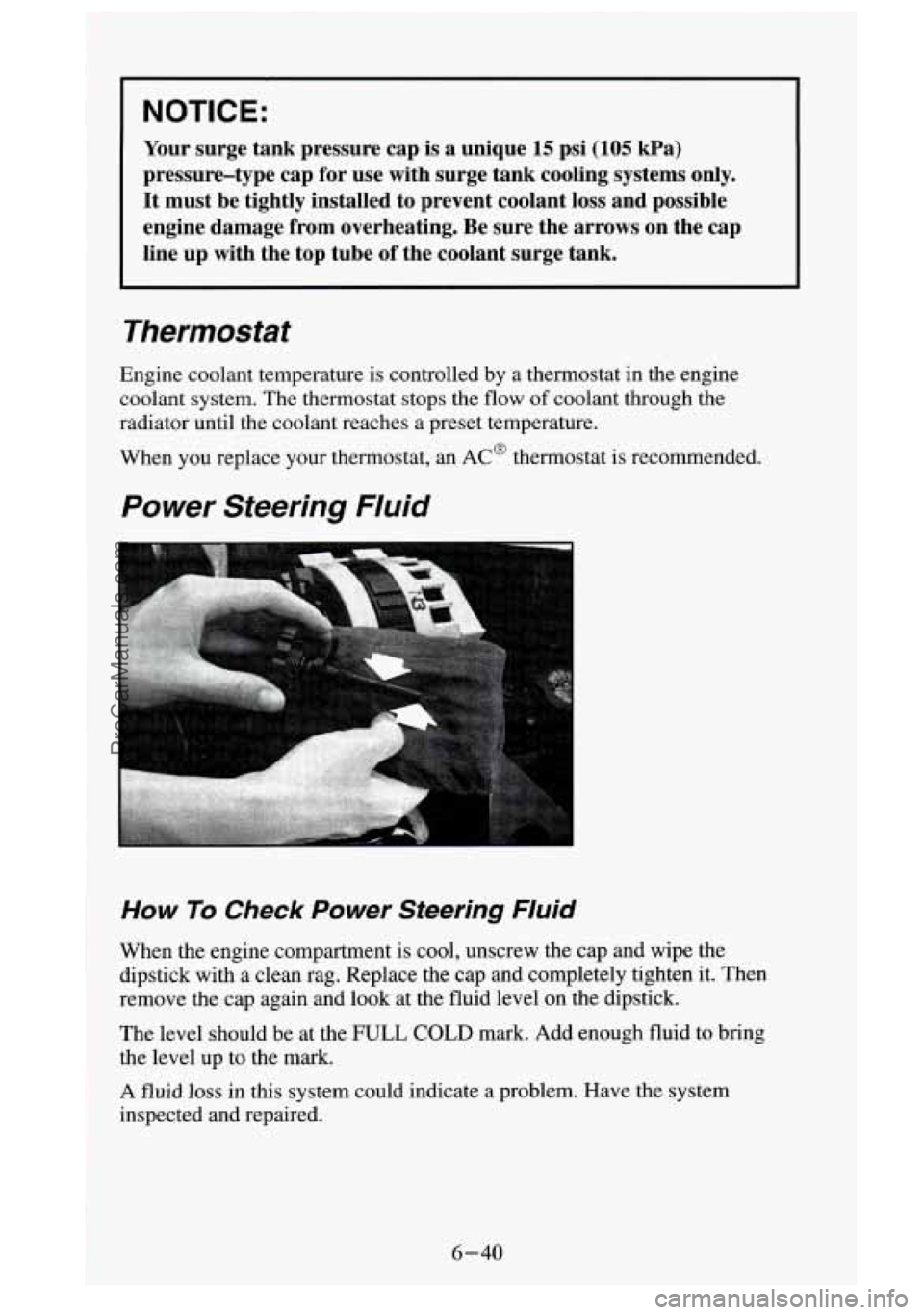
NOTICE:
Your surge tank pressure cap is a unique 15 psi (105 kPa)
pressure-type cap for use with surge tank cooling systems only.
It must be tightly installed to prevent coolant loss and possible
engine damage from overheating. Be sure the arrows on the cap
line up with the top tube of the coolant surge tank.
Thermostat
Engine coolant temperature is controlled by a thermostat in the engine
coolant system. The thermostat stops the flow
of coolant through the
radiator until the coolant reaches a preset temperature.
When you replace your thermostat, an AC@ thermostat is recommended.
Power Steering Fluid
How To Check Power Steering Fluid
When the engine compartment is cool, unscrew the cap and wipe \
the
dipstick with a clean rag. Replace the cap and completely tighten it. Then
remove the cap again and look at the fluid level on the dips\
tick.
The level should be at the
FULL COLD mark. Add enough fluid to bring
the level
up to the mark.
A fluid loss in this system could indicate a problem. Have the system
inspected and repaired.
6-40
ProCarManuals.com
Page 307 of 488
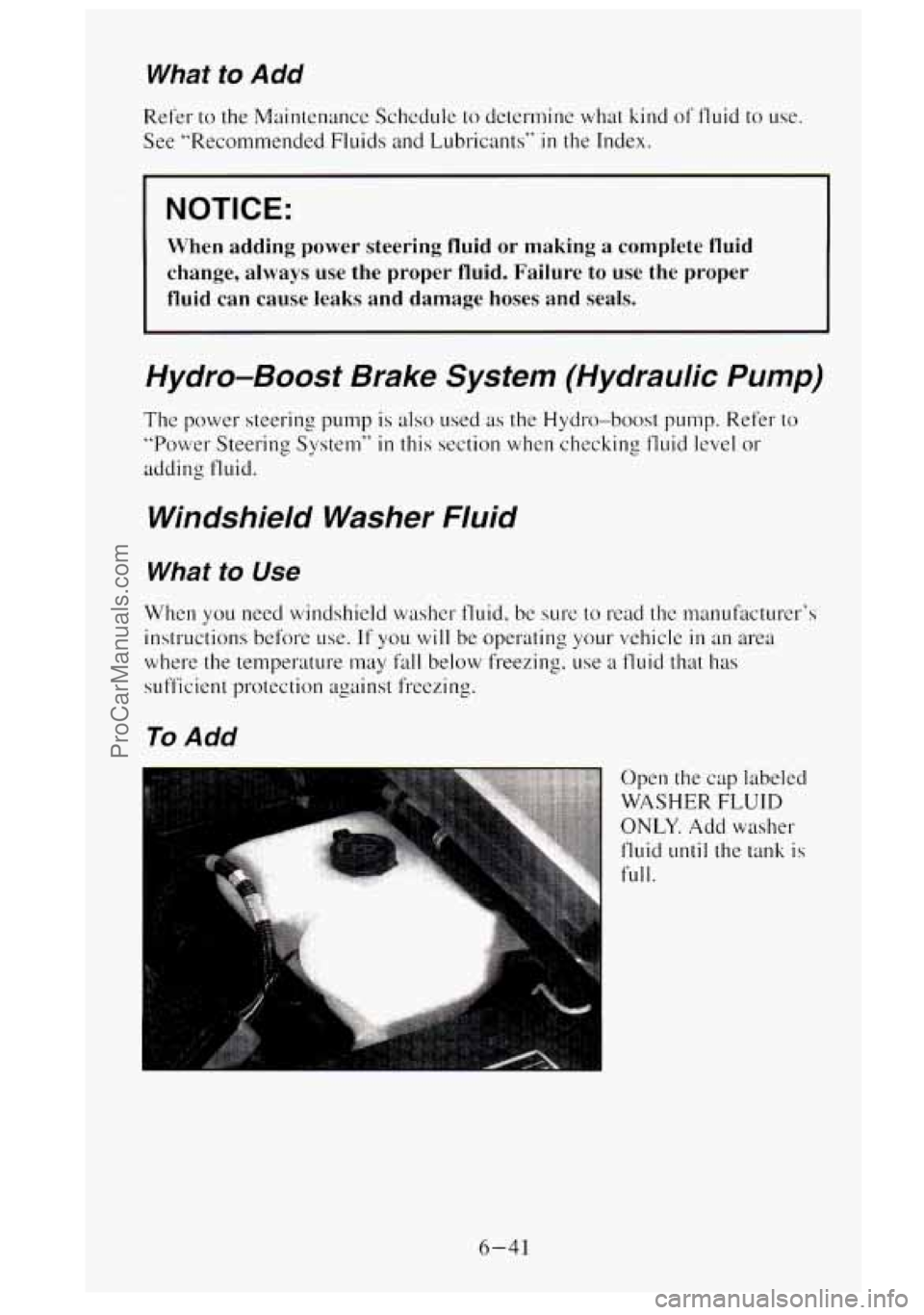
What to Add
Refer to the Maintenance Schedule to determine what kind of' tluid to use
See "Recommended Fluids and Lubricants"
in the Index.
NOTICE:
When adding power steering fluid or making a complete fluid
change, always use the proper fluid. Failure to use
the proper
fluid can cause leaks and damage hoses and seals.
Hydro-Boost Brake System (Hydraulic Pump)
The power steering pump is also used as the Hydro-boost pump. Refer to
"Power Steering System''
in this section when checking fluid level or
adding fluid.
Windshield Washer Fluid
What to Use
When you need windshield washer fluid, be sure to read the manuhcturer's
instructions before use.
If you will be operating your vehicle in an area
where the temperature
may fall below freezing, use a fluid that has
sufficient protection against freezing.
To Add
Open the cap labeled
WASHER FLUID
ONLY. Add washer
fluid
until the tank is
full.
6-41
ProCarManuals.com
Page 453 of 488
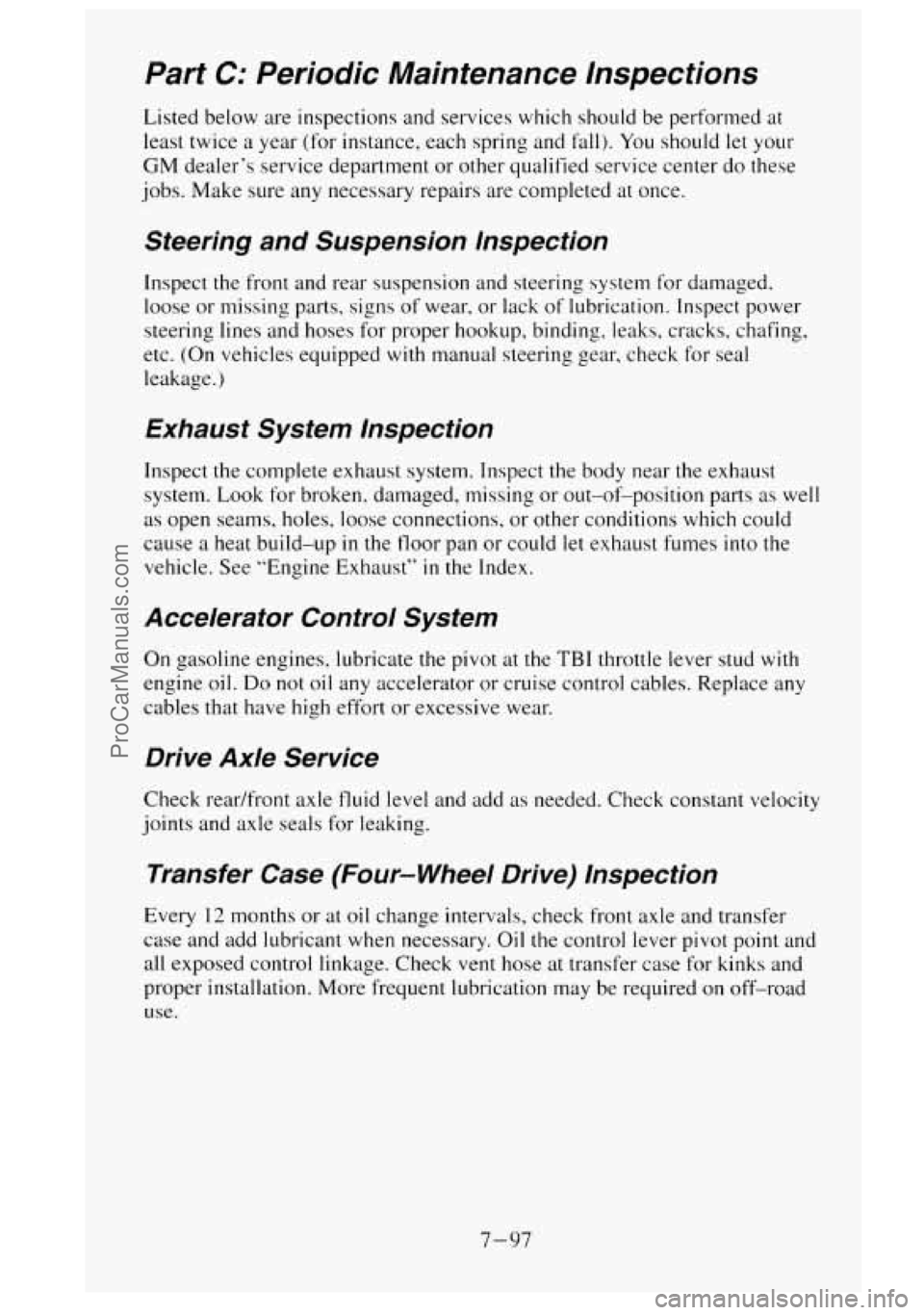
Part C: Periodic Maintenance lnspections
Listed below are inspections and services which should be performed at
least twice a year (for instance, each spring and
fall). You should let your
GM dealer’s service department or other qualified service center do these
jobs. Make sure any necessary repairs are completed at once.
Steering and Suspension Inspection
Inspect the front and rear suspension and steering system for damaged.
loose or missing parts, signs of wear,
or lack of lubrication. Inspect power
steering lines and hoses for proper hookup, binding, leaks, cracks, chafing,
etc. (On vehicles equipped with manual steering gear, check for seal
leakage.)
Exhaust System Inspection
Inspect the complete exhaust system. Inspect the body near the exhaust
system.
Look for broken. damaged, missing or out-of-position parts as well
as open seams, holes, loose connections,
or other conditions which could
cause a heat build-up
in the floor pan or could let exhaust fumes into the
vehicle. See “Engine Exhaust”
in the Index.
Accelerator Control System
On gasoline engines. lubricate the pivot at the TBI throttle lever stud with
engine
oil. Do not oil any accelerator or cruise control cables. Replace any
cables that have high effort or excessive wear.
Drive Axle Service
Check readfront axle fluid level and add as needed. Check constant velocity
Joints and axle seals for leaking.
Transfer Case (Four- Wheel Drive) Inspection
Every 12 months or at oil change intervals, check front axle and transfer
case and add lubricant when necessary. Oil the control lever pivot point and
all exposed control linkage. Check vent hose at transfer case for kinks and
proper installation. More frequent lubrication may be required on off-road
use.
7-97
ProCarManuals.com
Page 455 of 488
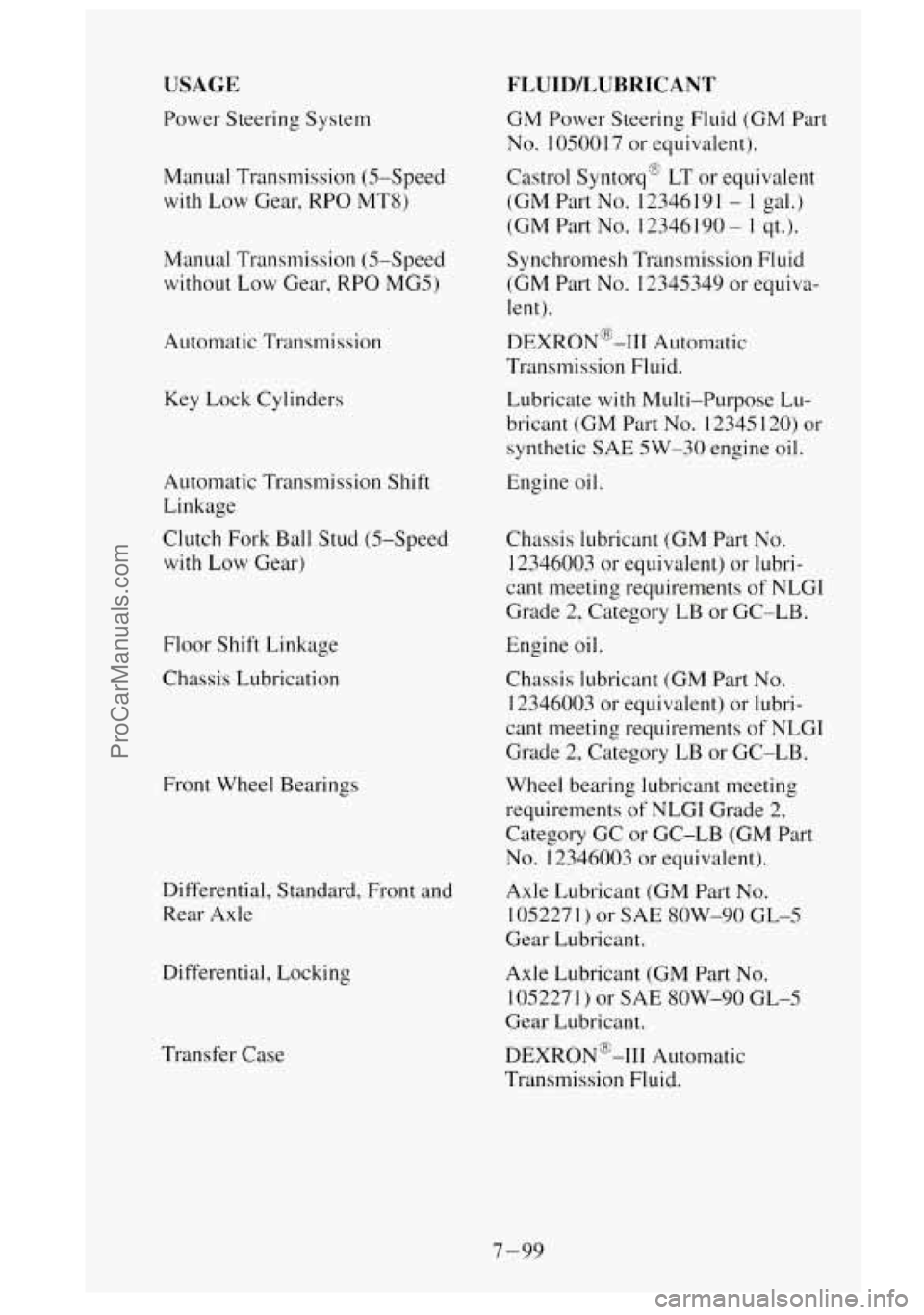
USAGE
Power Steering System Manual Transmission (5-Speed
with Low Gear, RPO MT8)
Manual Transmission (5-Speed
without Low Gear, RPO MG5)
Automatic Transmission Key Lock Cylinders
FLUIDLUBRICANT
GM Power Steering Fluid (GM Part
No. 10500 I7 or equivalent).
Castrol Syntorq'
LT or equivalent
(GM Part No. 12346191
- 1 gal.)
(GM Part
No. I23461 90 - 1 qt.).
Synchromesh Transmission Fluid
(GM Part
No. 12345349 or equiva-
lent).
DEXR0N'-I11 Automauc
Transmission Fluid.
Lubricate
with Multi-Purpose Lu-
bricant (GM Part No. I2345 120) or
synthetic SAE SW-30 engine oil.
Automatic Transmission Shift
Linkage
Clutch Fork Ball Stud (5-Speed
with Low Gear)
Floor Shift Linkage
Chassis Lubrication
Front Wheel Bearings
Differential, Standard, Front and
Rear Axle
Differential, Locking
Transfer Case Engine
oil.
Chassis lubricant (GM Part
No.
12346003 or equivalent) or lubri-
cant meeting requirements of NLGI
Grade 2, Category LB or GC-LB.
Engine
oil.
Chassis lubricant (GM Part No.
I2346003 or equivalent) or lubri-
cant meeting requirements of NLGI
Grade
2, Category LB or GC-LB.
Wheel bearing lubricant meeting
requirements
of NLGI Grade 2,
Category GC or GC-LB (GM Part
No. I2346003 or equivalent).
Axle Lubricant (GM Part No.
105227
1 ) or SAE 8OW-90 GL-5
Gear Lubricant.
Axle Lubricant (GM Part
No.
105227 1) or SAE 80W-90 GL-5
Gear Lubricant.
DEXR0N"-111 Automatic
Transmission Fluid.
7-99
ProCarManuals.com
Page 479 of 488
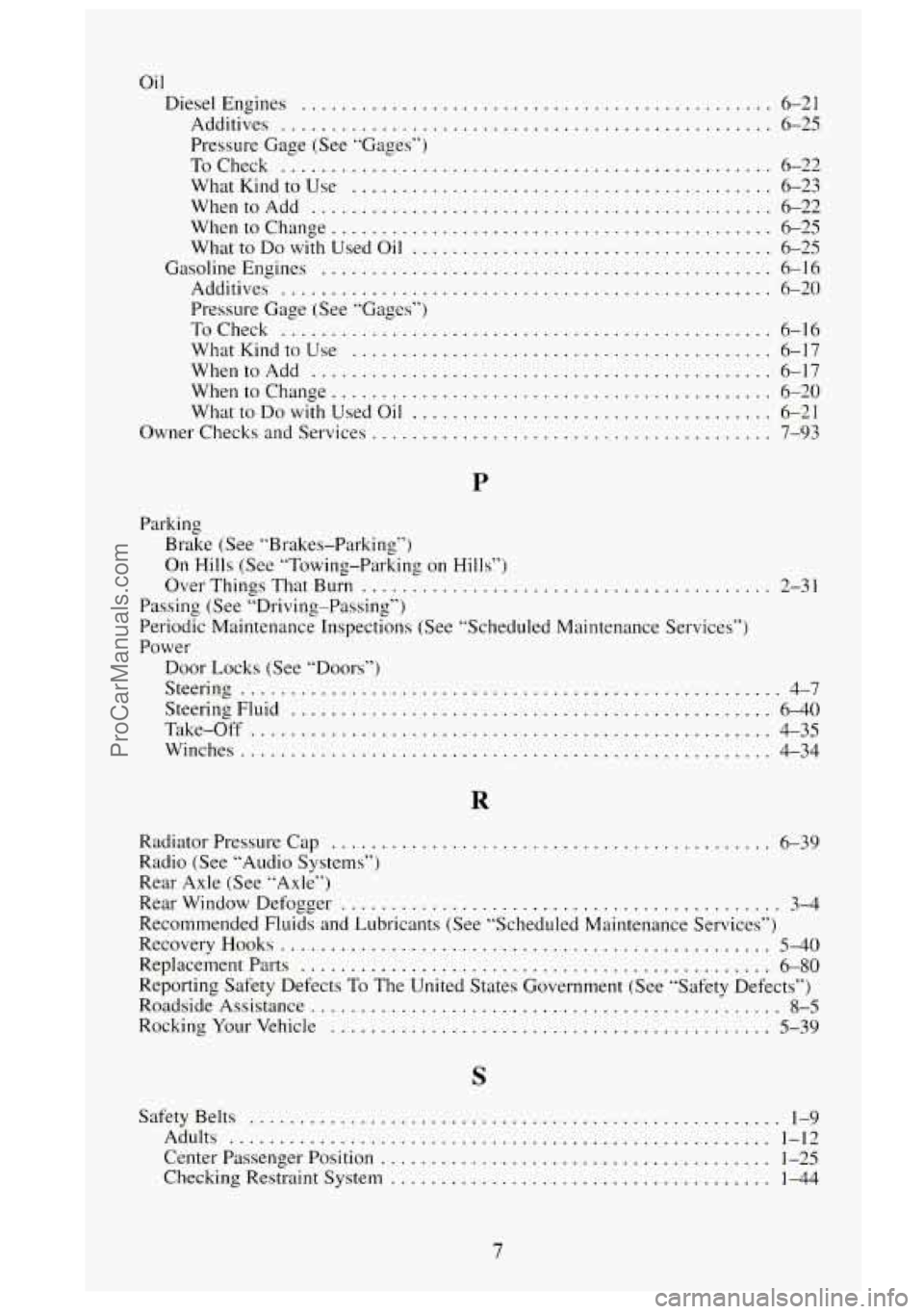
Oil DieselEngines
............................................... 6-21
Additives
................................................. 6-25
Pressure Gage (See “Gages”
j
ToCheck ................................................. 6-22
WhatKindtoUse
.......................................... 6-23
WhentoAdd
.............................................. 6-22
WhentoChange
............................................ 6-25
What to Do with Used Oil
.................................... 6-25
Gasoline Engines
............................................. 6-16
Additives
................................................. 6-20
Pressure Gage (See “Gages”)
ToCheck
................................................. 6-16
WhatKindtoUse
.......................................... 6-17
WhentoAdd .............................................. 6-17
When to Change ............................................ 6-20
What to Do with Used
Oil .................................... 6-21
Owner Checks and Services
........................................ 7-93
Parking Brake (See “Brakes-Parking”)
On Hills (See “Towing-Parking on Hills’*j
Over Things That Burn
........................................
Passing (See “Drivin~-Passing”)
Periodic Maintenance Inspections (See “Scheduled Maintenance Services”)
Power
Door Locks (See “Dood’j 2-31
Steering
...................................................... 4-7
Steering Fluid
................................................ 640
Take-Off
.................................................... 4-35
Winches
..................................................... 4-34
Radiator Pressure Cap
............................................ 6-39
Radio (See “Audio Systems”)
Rear Axle (See ”Axle”)
Recommended Fluids and Lubricants (See “Scheduled Maintenance Services“)
Recovery Hooks
................................................. 5-40
Replacement Parts ............................................... 6-80
Reporting Safety Defects To The United States Government (See “Safety Defects”)
Roadside Assistance
............................................... 8-5
Rocking Your Vehicle ............................................ 5-39
Rear Window Defogger
............................................ 3-4
Safety Belts ..................................................... 1-9
Adults ...................................................... 1-12
Center Passenger Position ....................................... 1-25
Checking Restraint System ...................................... 1-44
7
ProCarManuals.com